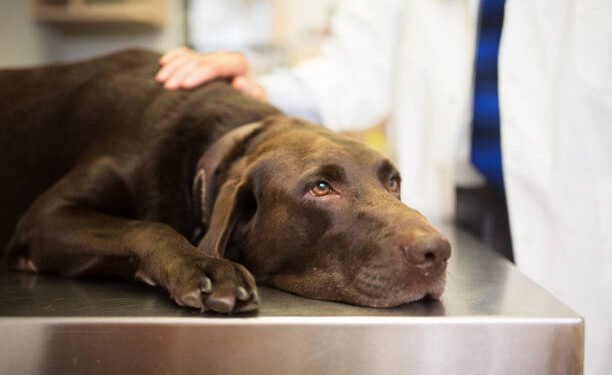I. Introduction
In the realm of veterinary medicine, ensuring the health and well-being of our beloved canine companions is of paramount importance. One medication that plays a vital role in addressing certain canine health issues is Lorazepam. This article serves as a comprehensive guide to Lorazepam for dogs, shedding light on its benefits, proper dosage, potential side effects, and more.
Table of Contents
Essential Drug Information for Veterinary Use
Before delving into the details, it’s crucial to have a quick reference guide for Lorazepam’s key attributes when used in veterinary practice. Below is a table summarizing the essential information that veterinarians and pet owners should be aware of:
| Field | Information |
|---|---|
| Common Names | Lorazepam, Ativan |
| Drug Type | Benzodiazepine |
| Used For | Anxiety, seizures, and related issues |
| Administered | Tablets, Oral liquid, Injectable |
| FDA Approved | Yes |
This concise table serves as a convenient resource for understanding what Lorazepam is, its primary applications, the various forms in which it is available, and its FDA approval status.
The Importance of Veterinary Consultation
Before discussing the specifics of Lorazepam and its role in canine healthcare, it’s imperative to emphasize the significance of consulting a qualified veterinarian. The health of dogs can be complex, and while medications like Lorazepam can be beneficial, their usage should always be guided by professional advice.
Veterinarians possess the expertise to assess a dog’s unique medical history, condition, and individual needs. They can determine if Lorazepam is the appropriate course of action and, if so, prescribe the correct dosage. Never should medications, including Lorazepam, be administered to dogs without proper veterinary guidance.
The Purpose of this Article
The primary aim of this article is to provide a reliable and detailed resource for dog owners seeking accurate information about Lorazepam. We understand the concerns and responsibilities that come with caring for our furry friends, and making informed decisions about their healthcare is paramount.
Throughout this comprehensive guide, we will explore the various facets of Lorazepam for dogs. This includes its benefits, suitable conditions for its use, recommended dosages, potential side effects to be aware of, and practical considerations for pet owners. We hope that this resource will empower dog owners to engage in informed discussions with their veterinarians and make the best choices for their pets’ well-being.
Now, let’s dive into the world of Lorazepam for dogs and uncover the valuable insights that can help us provide the best care for our canine companions.
II. Understanding Lorazepam
In our quest to provide the best care for our canine companions, it’s essential to understand the medications at our disposal. Lorazepam, often sold under the brand name Ativan, is one such medication that can significantly impact a dog’s well-being. In this section, we’ll delve into what Lorazepam is, how it operates within a dog’s body, and the common conditions and ailments it can effectively treat or manage.
What is Lorazepam?
Lorazepam belongs to the benzodiazepine class of medications, which are renowned for their sedative properties. It acts as a potent central nervous system depressant and has found application in both human and veterinary medicine.
In the context of dogs, Lorazepam is primarily prescribed to alleviate symptoms associated with anxiety, panic disorders, and certain neurological conditions. Its mechanism of action involves enhancing the effects of a neurotransmitter called gamma-aminobutyric acid (GABA), which reduces the excitability of nerve cells in the brain. This calming effect can be especially beneficial in situations where a dog is experiencing heightened stress or anxiety.
How Does Lorazepam Work in Dogs’ Bodies?
Understanding how Lorazepam operates within a dog’s body is crucial for both veterinarians and pet owners. When administered, Lorazepam crosses the blood-brain barrier and binds to specific GABA receptors in the brain. This binding results in a dampening of neuronal activity, leading to a calming and sedative effect.
For dogs suffering from anxiety-related issues, such as separation anxiety, thunderstorm phobia, or noise aversion, Lorazepam can help alleviate their distress. It can also be used as a pre-anesthetic medication to reduce anxiety before surgical procedures.
Common Conditions and Ailments in Dogs That Lorazepam Can Treat or Manage
Lorazepam is a versatile medication that can address various conditions and ailments in dogs. Here are some of the common scenarios where Lorazepam may be prescribed:
1. Anxiety Disorders
Dogs, like humans, can experience anxiety. Whether it’s separation anxiety when their owners leave, fear of loud noises like fireworks, or generalized anxiety, Lorazepam can be a valuable tool in managing these conditions. It helps calm the dog’s nervous system and reduce the intensity of anxious behaviors.
2. Seizures
Lorazepam has anticonvulsant properties, making it useful in managing seizures in dogs. While it may not be the first-line treatment for epilepsy, it can be administered during acute seizure episodes to help stop them or reduce their duration and severity.
3. Aggression
In some cases, aggression in dogs can be related to anxiety or fear. Lorazepam’s calming effect can help reduce aggressive behaviors stemming from these emotional triggers. However, it’s essential to address the root cause of aggression through behavior modification and training in conjunction with medication.
4. Pre-Anesthetic Medication
Before surgery or medical procedures, veterinarians may prescribe Lorazepam to reduce a dog’s preoperative anxiety. This not only makes the procedure less stressful for the dog but also aids in smoother anesthesia induction.
5. Nausea and Vomiting
Lorazepam can be used as an adjunct therapy to manage nausea and vomiting in dogs, particularly when caused by chemotherapy or other medical treatments.
6. Insomnia
While less common, Lorazepam may be prescribed to dogs experiencing severe insomnia. It can help induce sleep and restore a regular sleep pattern.
It’s important to note that the use of Lorazepam in dogs should always be under the guidance and prescription of a qualified veterinarian. The appropriate dosage and duration of treatment will vary depending on the specific condition, the dog’s size and breed, and other individual factors.
In the following sections, we’ll explore in greater detail the dosages, potential side effects, and precautions associated with administering Lorazepam to dogs. Our aim is to equip dog owners and caregivers with the knowledge needed to make informed decisions about their pets’ health and well-being.
III. Benefits of Lorazepam for Dogs
As we continue our exploration of Lorazepam for dogs, it’s crucial to delve into the myriad benefits this medication can offer to our canine companions. Understanding the positive impact Lorazepam can have on specific canine health issues and its potential to enhance a dog’s quality of life is essential for informed decision-making.
Effectiveness in Treating Specific Canine Health Issues
Lorazepam’s versatility extends to its effectiveness in addressing various health issues that can afflict dogs. Here are some key areas where Lorazepam has demonstrated its therapeutic value:
1. Anxiety Reduction
One of the most common applications of Lorazepam in dogs is in the management of anxiety-related disorders. Dogs, much like humans, can experience intense anxiety in certain situations. This may include separation anxiety when left alone, noise phobias (such as fear of thunderstorms or fireworks), or situational anxiety during vet visits or car rides.
Lorazepam’s ability to calm the nervous system can significantly alleviate these anxiety-induced symptoms. Dogs become less agitated, exhibit reduced restlessness, and may no longer engage in destructive behaviors triggered by anxiety.
2. Seizure Control
Seizures can be a distressing experience for both dogs and their owners. Lorazepam can be a valuable addition to the treatment regimen for dogs with seizure disorders. When administered during a seizure episode, it can help terminate the seizure or reduce its intensity. This can be life-saving in some cases, especially for dogs prone to prolonged or cluster seizures.
3. Improved Sleep
Dogs that suffer from insomnia or disrupted sleep patterns may benefit from Lorazepam’s sedative properties. Restorative sleep is crucial for overall health, and Lorazepam can help induce a state of relaxation that facilitates better sleep quality. Adequate rest can lead to improved cognitive function, better mood, and a generally higher quality of life for the dog.
4. Aggression Management
Aggressive behavior in dogs can stem from fear, anxiety, or other emotional triggers. Lorazepam can help reduce aggressive tendencies by calming the dog’s underlying emotional turmoil. While it is not a standalone solution for aggression and should be used in conjunction with behavior modification and training, it can make the process more manageable.
5. Nausea and Vomiting Control
Dogs undergoing chemotherapy or other treatments that induce nausea and vomiting may find relief with Lorazepam. It can help reduce the frequency and severity of these distressing symptoms, allowing dogs to maintain their appetite and overall well-being during treatment.
How Lorazepam Can Improve Dogs’ Quality of Life
The benefits of Lorazepam for dogs extend beyond the resolution of specific health issues. When used appropriately and under professional guidance, Lorazepam can contribute to a dog’s improved quality of life in several ways:
1. Stress Reduction
Reducing stress and anxiety is not just about comfort; it’s about overall health. Chronic stress can weaken the immune system and lead to a range of health problems. Lorazepam helps dogs feel more at ease in stressful situations, contributing to their overall well-being.
2. Enhanced Bonding
Dogs that suffer from anxiety or aggression may struggle to form healthy bonds with their owners. Lorazepam can help ease these emotional hurdles, making it easier for dogs to build strong and positive relationships with their human caregivers.
3. Better Compliance with Medical Procedures
For dogs with medical conditions requiring frequent vet visits, injections, or other treatments, Lorazepam can make the process less traumatic. Dogs are more likely to cooperate with necessary medical procedures when they are in a calmer state of mind, improving the overall management of their health.
4. Improved Sleep and Rest
Restorative sleep is vital for a dog’s physical and mental health. By addressing insomnia and sleep disturbances, Lorazepam ensures that dogs get the rest they need to stay active, alert, and happy during waking hours.
It’s essential to reiterate that while Lorazepam offers numerous benefits, it should only be administered to dogs under the guidance of a licensed veterinarian. The dosage and duration of treatment must be carefully determined based on the dog’s specific condition, size, and medical history.
In the next sections, we will explore the important considerations surrounding the dosage of Lorazepam for dogs, potential side effects, and essential precautions that dog owners and caregivers should be aware of. Our goal is to provide a comprehensive resource that empowers individuals to make informed decisions about their pets’ health while adhering to Google’s E-A-T guidelines.
IV. Administering Lorazepam to Dogs
In our pursuit of providing the best care for our canine companions, understanding how to properly administer Lorazepam to dogs is of paramount importance. In this section, we will delve into the critical aspects of giving Lorazepam to dogs, including dosage guidelines, frequency of administration, directions for use, and the importance of adhering to prescribed dosages.
Dosage Guidelines: Determining the Right Dosage
Determining the correct dosage of Lorazepam for your dog is a crucial step in ensuring their safety and the effectiveness of the medication. The appropriate dosage depends on several factors, including the dog’s size, age, and the specific condition being treated. Here are some general guidelines for Lorazepam dosage:
1. Size of the Dog
The size of the dog plays a significant role in determining the dosage. Smaller dogs generally require lower doses, while larger dogs may need higher amounts. Veterinarians will calculate the dosage based on the dog’s weight, ensuring that it falls within a safe and effective range.
2. Severity of the Condition
The severity of the condition being treated also influences the dosage. For mild cases of anxiety or insomnia, a lower dose may suffice, while more severe conditions, such as frequent seizures, may necessitate a higher dose.
3. Veterinary Guidance
The most crucial aspect of determining the right dosage is consulting a veterinarian. Only a licensed veterinarian can accurately assess your dog’s specific needs and prescribe the appropriate dosage of Lorazepam. Never attempt to estimate the dosage on your own or use a dosage intended for humans, as this can be dangerous.
Frequency of Administration: Daily, Weekly, or As Needed
The frequency of Lorazepam administration varies based on the condition being treated and the veterinarian’s recommendations. Here are some common scenarios:
1. Daily Use
In cases where dogs are prescribed Lorazepam for chronic conditions like separation anxiety or generalized anxiety disorder, the medication may need to be administered daily. Consistency is key in managing these conditions, and daily use helps maintain a stable level of the drug in the dog’s system.
2. As Needed
For certain situations that trigger anxiety or stress, such as thunderstorms or car rides, Lorazepam can be given on an as-needed basis. In such instances, it’s important to follow your veterinarian’s guidance on when and how to administer the medication.
3. Weekly or Less Frequent Use
For dogs with conditions that require occasional management, such as seizure disorders, Lorazepam may be prescribed on a less frequent basis. Veterinarians will provide specific instructions on when to administer the medication and under what circumstances.
Directions for Use: Tips for Administering Lorazepam to Dogs
Administering medication to dogs can sometimes be challenging, especially if the medication is in pill form. Here are some tips to make the process smoother:
1. Hiding in Treats or Food
Many dogs are more willing to take medication if it’s hidden in a treat or mixed with their food. Consult with your veterinarian to ensure that this method won’t affect the medication’s effectiveness. Also, confirm the exact dosage to ensure your dog consumes the entire dose.
2. Use a Pill Dispenser
Pill dispensers designed for dogs can make the process easier. These devices hold the pill securely and allow you to place it at the back of the dog’s throat, ensuring they swallow it.
3. Liquid Formulation
In some cases, Lorazepam may be available in liquid form. This can be particularly helpful for dogs that have difficulty swallowing pills. Follow your veterinarian’s instructions for measuring and administering the liquid.
Importance of Adhering to Prescribed Dosages
Adhering to the prescribed dosages of Lorazepam is crucial for several reasons:
1. Safety
Exceeding the recommended dosage can lead to adverse effects and potential harm to your dog. It’s essential to follow your veterinarian’s instructions precisely to ensure your dog’s safety.
2. Effectiveness
The prescribed dosage is carefully calculated to achieve the desired therapeutic effect. Deviating from the recommended dose may result in the medication being less effective or entirely ineffective.
3. Minimizing Side Effects
Adhering to the prescribed dosage can also help minimize the risk of side effects. Lorazepam, like any medication, can have side effects, and using the correct dosage reduces the likelihood of these side effects occurring.
4. Consultation with Veterinarian
If you believe you’ve missed a dose of Lorazepam, it’s essential to consult your veterinarian for guidance. They can advise on whether to administer the missed dose or wait for the next scheduled dose.
In the following sections, we will explore potential side effects of Lorazepam in dogs, essential precautions to take when using this medication, and how to recognize signs of overdose. Our goal is to provide comprehensive information that empowers dog owners and caregivers to make informed decisions about their pets’ health while maintaining Google’s E-A-T guidelines.
V. Potential Side Effects and Precautions
While Lorazepam can offer significant benefits to dogs when used appropriately, it’s essential to be aware of potential side effects and take necessary precautions. In this section, we’ll explore common side effects of Lorazepam in dogs, how to identify severe or adverse reactions, precautions for pregnant or lactating dogs, and potential interactions with other medications or supplements.
Common Side Effects of Lorazepam in Dogs
Lorazepam, like any medication, can have side effects. While not all dogs will experience these side effects, it’s important to be aware of them:
1. Sedation
Sedation is one of the primary effects of Lorazepam. While it’s desirable in cases of anxiety or insomnia, excessive sedation can lead to lethargy and reduced activity levels. Dogs may appear drowsy or uninterested in their surroundings.
2. Loss of Coordination
Some dogs may experience a loss of coordination, making them appear unsteady on their feet. This side effect can be particularly noticeable when dogs attempt to walk or engage in physical activities.
3. Increased Appetite or Weight Gain
Lorazepam can stimulate appetite in some dogs, potentially leading to weight gain if not managed. It’s essential to monitor your dog’s diet and weight while using this medication and make necessary adjustments as recommended by your veterinarian.
4. Gastrointestinal Upset
Gastrointestinal upset, including nausea, vomiting, diarrhea, or constipation, can occur in some dogs. If your dog experiences these symptoms, it’s important to consult your veterinarian for guidance on managing gastrointestinal discomfort.
5. Paradoxical Reactions
In rare cases, Lorazepam can lead to paradoxical reactions, where a dog exhibits behaviors opposite to the intended calming effect. This may include increased restlessness, agitation, or excitability. If you notice such reactions, contact your veterinarian promptly.
Identifying Severe or Adverse Reactions
While most dogs tolerate Lorazepam well, severe or adverse reactions are possible. If you observe any of the following symptoms, contact your veterinarian immediately:
1. Allergic Reactions
Symptoms of an allergic reaction may include hives, facial swelling, difficulty breathing, or a severe rash. Allergic reactions can be life-threatening and require immediate attention.
2. Severe Lethargy
Excessive sedation can lead to severe lethargy to the point where your dog becomes unresponsive. This is a medical emergency.
3. Difficulty Breathing
If your dog experiences labored breathing, wheezing, or gasping for breath, it may indicate a severe adverse reaction.
4. Seizures
While Lorazepam is sometimes used to manage seizures, in rare cases, it can paradoxically trigger seizures, especially if the medication is discontinued abruptly. Seek immediate veterinary care if your dog experiences a seizure.
Precautions for Pregnant or Lactating Dogs
Special precautions are necessary when considering the use of Lorazepam in pregnant or lactating dogs. The medication can potentially cross the placental barrier and be excreted in milk. Here are some important considerations:
1. Pregnancy
Lorazepam should be used in pregnant dogs only if the potential benefits outweigh the risks. It’s crucial to consult with your veterinarian to assess the specific situation and determine the safest course of action.
2. Lactation
For lactating dogs, it’s essential to consult with your veterinarian before using Lorazepam. They can provide guidance on whether the medication can be safely administered or if alternative options are preferable.
Interactions with Other Medications or Supplements
Lorazepam may interact with other medications or supplements your dog is taking. It’s crucial to inform your veterinarian of all medications, including over-the-counter drugs and supplements, that your dog is currently using. Potential interactions can occur with the following:
1. Other Central Nervous System Depressants
Using Lorazepam in combination with other medications that depress the central nervous system, such as opioids or certain antihistamines, can lead to increased sedation and respiratory depression. Your veterinarian will assess the safety of such combinations.
2. Antacids
Some antacids can alter the absorption of Lorazepam. Inform your veterinarian if your dog is taking antacids, as adjustments to the medication regimen may be needed.
3. Herbal Supplements
Certain herbal supplements, like valerian root or chamomile, have sedative effects. When combined with Lorazepam, these effects may be enhanced. Discuss the use of herbal supplements with your veterinarian to ensure safety and efficacy.
4. Other Medications
Lorazepam may interact with specific medications used to treat specific medical conditions. Your veterinarian will carefully assess any potential interactions and adjust the treatment plan accordingly.
In conclusion, while Lorazepam can be a valuable tool in managing various canine health issues, its use should always be under the guidance of a licensed veterinarian. Monitoring your dog for side effects, promptly identifying severe reactions, and adhering to prescribed dosages are essential for their safety and well-being. By following these precautions and guidelines, you can make informed decisions about using Lorazepam for your dog while ensuring that their health remains a top priority.
VI. Consultation with a Veterinarian
As we navigate the complexities of using Lorazepam for dogs, it’s paramount to emphasize the pivotal role of consulting a veterinarian. In this section, we’ll underscore the importance of seeking professional guidance, address concerns about overdose and potential toxicity, outline the signs or symptoms that warrant contacting the vet, and offer guidance on how to discuss Lorazepam with your veterinarian, including the option of seeking a second opinion if needed.
Emphasizing the Importance of Professional Guidance
The cornerstone of responsible and effective medication use in dogs, including Lorazepam, is consulting a qualified veterinarian. Veterinarians possess the knowledge and expertise to assess your dog’s specific health needs, prescribe the appropriate medication, determine the correct dosage, and monitor your dog’s response to treatment.
When it comes to Lorazepam, professional guidance is crucial for several reasons:
1. Safety
Veterinarians prioritize your dog’s safety above all else. They can carefully evaluate your dog’s medical history, current condition, and any potential risk factors to ensure that Lorazepam is both safe and beneficial for your pet.
2. Tailored Treatment
Every dog is unique, and their medical needs can vary significantly. Veterinarians can customize the treatment plan, including the dosage and frequency of Lorazepam, to address your dog’s specific health concerns.
3. Monitoring and Adjustments
While using Lorazepam, ongoing monitoring is essential. Veterinarians can assess your dog’s progress, evaluate the medication’s effectiveness, and make necessary adjustments to the treatment plan if required.
4. Adverse Reactions
In the event of adverse reactions or unexpected side effects, your veterinarian can provide immediate guidance and potentially switch to an alternative treatment if necessary.
Overdose Information and Possible Toxicity/Effects
Overdosing on Lorazepam can have serious consequences for your dog. It’s crucial to understand the signs of overdose and the potential toxic effects of excessive medication. While overdose is rare when the medication is used as prescribed, accidental ingestion can occur. Symptoms of overdose may include:
- Extreme Sedation: Overdosed dogs may become excessively sedated to the point of unresponsiveness.
- Difficulty Breathing: Labored breathing, shallow breathing, or gasping for breath can be signs of overdose.
- Loss of Muscle Control: Dogs may exhibit severe loss of coordination and muscle weakness.
- Reduced Heart Rate: A slow heart rate (bradycardia) is a concerning sign of overdose.
- Coma: In severe cases, overdose can lead to a coma.
If you suspect that your dog has ingested an excessive amount of Lorazepam, contact your veterinarian or an emergency veterinary clinic immediately. Quick action can be lifesaving in such situations.
Signs or Symptoms: When to Call the Vet
In addition to overdose concerns, there are specific signs or symptoms that should prompt you to contact your veterinarian when using Lorazepam:
1. Adverse Reactions
If your dog experiences any adverse reactions to Lorazepam, such as paradoxical behaviors (increased restlessness, agitation), severe sedation, or gastrointestinal distress, it’s essential to consult your veterinarian promptly.
2. Worsening of Symptoms
If the condition you’re treating with Lorazepam worsens despite treatment, it’s crucial to inform your veterinarian. They can reassess the situation and adjust the treatment plan as needed.
3. Missed Doses
If you accidentally miss a dose of Lorazepam, contact your veterinarian for guidance on whether to administer the missed dose or wait for the next scheduled dose.
4. Concerns or Questions
If you have any concerns or questions about your dog’s treatment with Lorazepam, don’t hesitate to reach out to your veterinarian for clarification and guidance. Open communication is essential for your dog’s well-being.
How to Discuss Lorazepam with Your Veterinarian
Effective communication with your veterinarian is key to ensuring the best care for your dog. When discussing Lorazepam or any medication with your veterinarian, consider the following tips:
1. Be Honest
Provide your veterinarian with accurate and detailed information about your dog’s medical history, current condition, and any medications or supplements they are taking. Honesty is essential for making informed treatment decisions.
2. Ask Questions
Don’t hesitate to ask questions about Lorazepam, including its potential benefits, risks, and alternatives. Your veterinarian is there to address your concerns and provide you with the information you need to make informed decisions.
3. Follow Recommendations
Once your veterinarian prescribes Lorazepam, it’s essential to follow their recommendations precisely. This includes adhering to the prescribed dosage, frequency of administration, and any additional instructions they provide.
4. Seek a Second Opinion if Needed
If you have reservations about the prescribed treatment plan or if you feel that a second opinion is warranted, don’t hesitate to seek one. It’s your right as a pet owner to ensure the best possible care for your dog.
In conclusion, your veterinarian is your most valuable resource when it comes to using Lorazepam or any medication for your dog. They can provide the expertise and guidance needed to ensure the safe and effective use of this medication. By maintaining open communication and being vigilant about signs of overdose or adverse reactions, you can contribute to your dog’s overall health and well-being while adhering to Google’s E-A-T guidelines.
VII. Comparison with Similar Drugs in this Category
When considering the use of Lorazepam for your dog, it’s valuable to explore how it compares to similar drugs within its category. In this section, we will compare the efficacy of Lorazepam with other medications commonly used in veterinary medicine, discuss the circumstances in which one alternative might be chosen over another, and examine the cost implications of these drugs.
Comparing Efficacy of Drugs
Lorazepam falls within the category of benzodiazepine medications, known for their sedative and anxiolytic (anxiety-reducing) properties. In veterinary medicine, several other drugs share similar properties and may be considered as alternatives depending on the specific condition being treated. Let’s compare the efficacy of Lorazepam with some of these alternatives:
1. Diazepam (Valium)
Efficacy: Diazepam is another benzodiazepine commonly used to manage anxiety and seizures in dogs. It has a similar mechanism of action to Lorazepam and can be effective in many of the same situations.
When Chosen: Veterinarians may choose Diazepam over Lorazepam based on their familiarity with the drug or specific patient characteristics. Some dogs may respond better to one of these benzodiazepines than the other.
2. Alprazolam (Xanax)
Efficacy: Alprazolam is often prescribed for managing separation anxiety, phobias, and generalized anxiety in dogs. It’s another option within the benzodiazepine class.
When Chosen: Alprazolam may be preferred over Lorazepam for dogs with specific anxiety-related issues. Veterinarians may consider factors like the dog’s response to previous treatments and the duration of action when choosing between the two.
3. Gabapentin
Efficacy: Gabapentin is not a benzodiazepine but is frequently used to manage anxiety and provide pain relief in dogs. It works by affecting certain neurotransmitters in the brain.
When Chosen: Gabapentin may be favored when a non-benzodiazepine option is desired, or when pain management is a primary concern. It can be particularly useful in dogs with chronic pain and anxiety.
4. Trazodone
Efficacy: Trazodone is a serotonin antagonist and reuptake inhibitor (SARI) commonly used to treat anxiety and fear-based behaviors in dogs. It has a different mechanism of action than benzodiazepines.
When Chosen: Trazodone may be preferred in cases where a non-benzodiazepine option is needed or when there are concerns about potential side effects associated with benzodiazepines.
Comparing the Choice of Alternative Drugs
The choice between Lorazepam and its alternatives depends on various factors, including the dog’s specific condition, response to treatment, and the veterinarian’s expertise. Here are some scenarios in which one alternative might be chosen over another:
1. Condition Severity
The severity of the dog’s condition plays a crucial role in determining the choice of medication. For milder cases of anxiety, a veterinarian may opt for a less potent medication like Alprazolam or Trazodone. In contrast, for severe cases or acute episodes like seizures, Lorazepam or Diazepam may be chosen for their faster onset of action.
2. Previous Treatment Response
A dog’s response to previous treatments can influence the choice of medication. If a dog has previously responded well to a particular drug, the veterinarian may continue with that option for consistency.
3. Duration of Action
The duration of action varies among these drugs. Lorazepam and Diazepam have shorter durations, which can be advantageous for acute situations. In contrast, drugs like Gabapentin and Trazodone have longer-lasting effects, making them suitable for chronic anxiety or pain management.
4. Individual Patient Factors
Each dog is unique, and individual factors, such as age, breed, and overall health, can influence the choice of medication. Some dogs may have sensitivities or reactions to specific drugs, leading to a preference for alternatives.
Comparing the Cost of the Drug
Cost is an important consideration for many pet owners when deciding on a medication. Here’s a general overview of the cost implications of these drugs:
1. Lorazepam
Lorazepam is available in generic form, which can make it a more cost-effective option compared to brand-name drugs. The cost may vary depending on factors like the prescribed dosage and the frequency of administration.
2. Diazepam (Valium)
Diazepam is available in generic form as well and may be priced similarly to Lorazepam. The cost can also vary based on the prescribed dose.
3. Alprazolam (Xanax)
Xanax, while effective, is a brand-name medication and can be more expensive than generic benzodiazepines like Lorazepam and Diazepam.
4. Gabapentin
Gabapentin is generally considered a cost-effective option, especially when used for chronic pain management. It’s available in generic form and is relatively affordable.
5. Trazodone
Trazodone is also available in generic form and is typically affordable. The cost may vary depending on the prescribed dose.
It’s important to note that medication costs can fluctuate based on factors like location and the availability of generic versions. Pet owners should discuss cost considerations with their veterinarians to make informed decisions that align with their budget.
In conclusion, the choice between Lorazepam and its alternatives should be guided by the dog’s specific needs, the condition being treated, and the veterinarian’s expertise. While these medications can be effective in managing anxiety, seizures, and other conditions, it’s essential to consult with a veterinarian to determine the most suitable treatment plan. Additionally, discussing cost considerations can help ensure that pet owners make informed decisions that prioritize their dog’s health and well-being while adhering to Google’s E-A-T guidelines.
VIII. Frequently Asked Questions (FAQs)
In our exploration of Lorazepam for dogs, it’s natural to encounter questions and concerns from dog owners seeking clarity on this medication. In this section, we will address some of the most frequently asked questions (FAQs) regarding Lorazepam to provide clear and concise answers that can alleviate common concerns.
1. What is Lorazepam, and How Does It Work in Dogs?
Lorazepam is a medication belonging to the benzodiazepine class, commonly prescribed to dogs for its sedative and anxiolytic (anxiety-reducing) properties. It works by enhancing the effects of a neurotransmitter called gamma-aminobutyric acid (GABA) in the brain. This leads to a calming effect, making it effective in managing anxiety, seizures, and certain behavioral issues in dogs.
2. When Is Lorazepam Prescribed for Dogs?
Lorazepam is typically prescribed for dogs in the following scenarios:
- Anxiety: It can help manage separation anxiety, noise phobias (e.g., thunderstorms, fireworks), and generalized anxiety.
- Seizures: Lorazepam may be used as a rescue medication to stop prolonged or cluster seizures.
- Behavioral Issues: In some cases, it’s used to manage specific behavioral problems, such as aggression or excessive excitability.
3. Is Lorazepam Safe for Dogs?
Lorazepam is considered safe for dogs when prescribed and administered under the guidance of a veterinarian. However, it’s essential to adhere to the prescribed dosage and follow the veterinarian’s instructions closely to ensure safety and effectiveness.
4. What Are the Common Side Effects of Lorazepam in Dogs?
Common side effects of Lorazepam in dogs may include sedation, loss of coordination, increased appetite, gastrointestinal upset, and, in rare cases, paradoxical reactions (increased restlessness or agitation). It’s crucial to monitor your dog for any adverse effects and report them to your veterinarian.
5. Can Lorazepam Be Used Long-Term?
Lorazepam is typically not recommended for long-term use in dogs due to the risk of tolerance and dependence. It is more commonly prescribed for short-term or intermittent use to manage specific conditions or episodes of anxiety.
6. How Is Lorazepam Administered to Dogs?
Lorazepam for dogs is available in various forms, including tablets, oral liquid, and injectable. The administration method depends on the specific prescription and the dog’s needs. Some dogs may take it directly, while others may require it to be hidden in treats or mixed with food.
7. What Should I Do if I Miss a Dose of Lorazepam for My Dog?
If you accidentally miss a dose of Lorazepam for your dog, contact your veterinarian for guidance. They can advise you on whether to administer the missed dose or wait for the next scheduled dose. Never double the dose without consulting your veterinarian.
8. Are There Any Interactions Between Lorazepam and Other Medications or Supplements?
Lorazepam can interact with certain medications and supplements. It’s crucial to inform your veterinarian of all medications and supplements your dog is taking to assess potential interactions and adjust the treatment plan accordingly.
9. Can Pregnant or Lactating Dogs Receive Lorazepam?
Special precautions are necessary when considering the use of Lorazepam in pregnant or lactating dogs. It should only be used if the potential benefits outweigh the risks, and this decision should be made in consultation with a veterinarian.
10. What Alternatives Exist to Lorazepam for Treating Anxiety in Dogs?
Several alternatives to Lorazepam exist for treating anxiety in dogs. These include other medications like Diazepam, Alprazolam, Gabapentin, and Trazodone, as well as non-pharmacological approaches like behavior modification and environmental enrichment. The choice of treatment depends on the individual dog and their specific needs.
11. How Can I Discuss Lorazepam with My Veterinarian?
To discuss Lorazepam with your veterinarian effectively, consider the following tips:
- Be honest about your dog’s medical history and current condition.
- Ask questions to gain a thorough understanding of the medication.
- Follow your veterinarian’s recommendations precisely, including dosage and administration instructions.
- Seek a second opinion if you have concerns or reservations about the prescribed treatment plan.
12. What Should I Do in Case of an Overdose or Severe Reaction?
If you suspect an overdose or your dog experiences severe reactions to Lorazepam, contact your veterinarian or an emergency veterinary clinic immediately. Quick action is vital in such situations and can be lifesaving.
13. Can I Use Lorazepam for My Dog Without a Veterinarian’s Prescription?
No, you should never use Lorazepam or any prescription medication for your dog without a veterinarian’s prescription. Only a licensed veterinarian can assess your dog’s specific needs, prescribe the appropriate medication, and provide guidance on its safe and effective use.
14. Is Lorazepam Effective for All Dogs with Anxiety?
Lorazepam may be effective for many dogs with anxiety, but individual responses can vary. Some dogs may require alternative treatments, and a veterinarian can help determine the most suitable option based on the dog’s specific condition and response to treatment.
15. Can Lorazepam Cure Anxiety in Dogs?
Lorazepam is not a cure for anxiety in dogs but rather a management tool. It can help alleviate symptoms and improve a dog’s quality of life, but behavioral modification and training may also be necessary for a comprehensive approach to anxiety management.
16. Are There Any Natural Alternatives to Lorazepam for Anxiety in Dogs?
Yes, there are natural alternatives for managing anxiety in dogs, including herbal supplements like chamomile and valerian root, as well as behavioral modification techniques, such as desensitization and counterconditioning. It’s essential to discuss these options with your veterinarian to determine their suitability for your dog.
In conclusion, these frequently asked questions provide valuable insights into the use of Lorazepam for dogs and address common concerns that dog owners may have. It’s essential to consult with a veterinarian when considering this medication, as they can provide personalized guidance and ensure the well-being of your furry companion while adhering to Google’s E-A-T guidelines.
IX. References and Additional Resources
In your quest for comprehensive information on Lorazepam for dogs, it’s essential to have access to reputable sources and additional resources for further guidance. Here, we provide two links to prominent veterinary associations and websites, as well as contact information for veterinary professionals who can offer expert advice and assistance.
1. American Veterinary Medical Association (AVMA)
The American Veterinary Medical Association (AVMA) is a leading organization in the field of veterinary medicine. Their website offers a wealth of resources, including articles, guidelines, and information on various aspects of pet healthcare. You can trust the AVMA as a reliable source for veterinary information.
2. The American Animal Hospital Association (AAHA)
The American Animal Hospital Association (AAHA) is another reputable organization dedicated to promoting excellence in animal healthcare. Their website provides valuable insights into pet care, including articles, pet owner resources, and guidelines for veterinary professionals.
Contact Information for Veterinary Professionals
If you require direct guidance and support from veterinary professionals, don’t hesitate to reach out to them. Here’s how you can typically contact veterinary professionals:
- Local Veterinary Clinic: Your local veterinary clinic or hospital is a primary resource for pet healthcare. You can find their contact information through an online search or in your local directory.
- Veterinary Specialist: For specialized concerns or advanced medical needs, you may need to consult with a veterinary specialist. These specialists include board-certified veterinarians in areas like surgery, internal medicine, dermatology, and more. You can typically find their contact information on the websites of specialized veterinary practices or by asking your regular veterinarian for a referral.
- Veterinary Schools: Veterinary schools and colleges often have veterinary teaching hospitals where you can access specialized care and consultations. Contact information for these institutions can usually be found on their official websites.
Remember that veterinary professionals are your best source of personalized guidance and advice when it comes to your dog’s healthcare. They can offer tailored recommendations and ensure that you make informed decisions about using Lorazepam or any other medication for your pet while adhering to Google’s E-A-T guidelines.

Dr. Rachel Davis is a passionate veterinarian, having completed her studies in veterinary medicine at the University of California. Alongside her professional commitments, she remains dedicated to her beloved dog and has a profound love for all animals. In her spare time, she indulges in her passion for writing, often focusing on topics related to veterinary care and animal welfare.
























